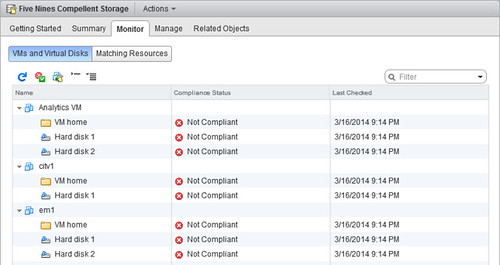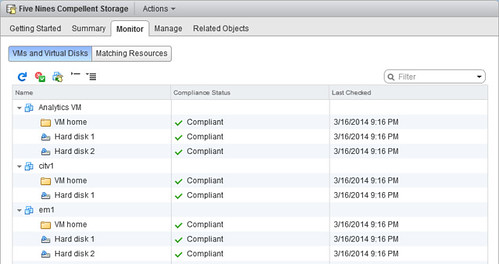Press Release
VMTurbo’s Disruptive Software-Driven Control Expands Across Storage and Fabric To Realize Full Value of Virtualization
VMTurbo Operations Manager Enables Customers to Realize 30%Improvement in Utilization while assuring application workload performance
BOSTON, MA – January 27, 2014 – VMTurbo, provider of the only Software-Driven Control for virtualized environments, today announced a new version of its flagship product, VMTurbo Operations Manager, enhanced with control modules for storage and fabric to drive virtualized environments to their desired state and maintain control in that state across the data center and IT stack. These new solutions enable 30% improvement in utilization while providing greater control over all aspects of the environment the application workload touches – from compute and storage to fabric and cloud.
One of the major advancements in this release is management of the Converged Fabric layer with Cisco (CSCO) UCS support. Not only does VMTurbo provide unprecedented visibility into UCS from the fabric interconnect down to individual blades, it also enables control of UCS to manage real demand for UCS ports to maximize port utilization and avoid unnecessary port licensing costs.
“We’ve made a significant investment in UCS and are happy with it but it’s a challenge to manage,” said Jonathan Brown, Desktop Administrator at Beaufort Memorial Hospital (www.bmhsc.org). “VMTurbo is the only solution we’ve found on the market that helps us understand the inner workings of UCS so we can better manage it. We love VMTurbo, and are excited for all the new features to help us manage the future growth of our environment.”
VMTurbo is also disrupting enterprise software with its model of “easy to try, buy, deploy, and use”. Customers download VMTurbo Operations Manager and realize value instantly – unlike traditional management software which takes several months to install and perform after significant integration costs. In fact, VMTurbo offers customers a free health check assessment of their virtual environments. With VMTurbo, customers can break free from expensive, monitoring solutions that fail to eliminate reactive and labor-intensive IT fire fighting..
“I learned more about my data center in 15 minutes with VMTurbo than I did in the last five years,” said Chuck Green, CIO of AlphaMaxx Healthcare, Inc., the premiere NCQA-accredited perinatal population health management firm. “It’s truly a paradigm shift.”
90% of customers that have implemented VMTurbo’s Software-Driven control system to manage their virtualized data centers and cloud infrastructures report a return-on-investment of less than three months from purchase – an unparalleled breakthrough disrupting traditional enterprise management software (Source: TechValidate).
VMTurbo was recently recognized last week by Forbes as one of 2014 America’s Most Promising Companies. Earlier in the year VMTurbo received the JP Morgan Hall of Innovation award, being named one of the most innovative technologies in the data center.
“VMTurbo’s technology is helping JPMorgan Chase optimize the utilization of virtual environments and thereby supporting a move from reactive to predictive workload management,” said George Sherman, Head of Compute Services at JPMorgan Chase. “Automation will enable our support teams to focus on higher value activity by preventing incidents and dynamically optimizing virtual environments.”
VMTurbo Operations Manager
VMTurbo Operations Manager is the only product on the market understanding application workload performance, resource utilization and constraints in virtualized datacenter and cloud deployments to drive an organization’s environment to its desired state – that state of perpetual health where application performance is assured while maximizing efficiency – while providing control over all aspects of the environment the application workload touches, from compute and storage to fabric and cloud. While competitive solutions focus on viewing – monitoring systems to send alerts requiring operational staff to troubleshoot and remedy issues – VMTurbo Operations Manager ties the viewing with the doing, so IT Operations staff can elevate their focus from reactive to strategic. To try VMTurbo Operations Manager in your own environment, visit www.vmturbo.com/download or for a free health check assessment, call 1.877.978.8818 .
For more detailed information on VMTurbo Operations Manager, visit vmturbo.com/operations-manager.
VMTurbo Storage Control Module
VMTurbo’s Storage Control Module ensures applications get the storage performance they require to operate reliably while enabling efficient use of storage infrastructure – thus preventing unnecessary over provisioning. This module helps users solve their pressing storage performance and cost challenges, maximize their existing storage investments and embrace the adoption of advanced features and packaging such as NetApp Clustered Data ONTAP (cluster mode) and FlexPod. For more detailed information on VMTurbo Storage Control Module, visit www.vmturbo.com/storage-resource-management.
VMTurbo Fabric Control Module
Modern compute platforms and blade servers have morphed to fabrics unifying compute, network, virtualization and storage access into a single integrated architecture. Furthermore, fabrics like Cisco (CSCO) UCS form the foundation of a programmable infrastructure for today’s private clouds and virtualized datacenters, the backbone of converged infrastructure offerings from VCE vBlock and NetApp FlexPod.
With the addition of this Fabric Control Module, VMTurbo’s software-driven control system ensures workloads get the compute and network resources they need to perform reliably while maximizing the utilization of underlying blades and ports. For more detailed information on VMTurbo Fabric Control Module, visit www.vmturbo.com/ucs-management
About VMTurbo
VMTurbo’s Software-Driven Control platform enables organizations to manage cloud and enterprise virtualization environments to maximize infrastructure investments while assuring application performance. VMTurbo’s patent-pending Economic Scheduling Engine dynamically adjusts configuration, resource allocation and workload placement to meet service levels and business goals, and is the only technology capable of closing the loop in IT operation by automating the decision-making process to maintain an environment in its desired state. The VMTurbo platform first launched in August 2010 and since that time more than 10,000 cloud service providers and enterprises worldwide have deployed the platform, including JP Morgan Chase, Colgate-Palmolive and Ingram Micro. Using VMTurbo, our customers ensure that applications get the resources they need to operate reliably, while utilizing their most valuable infrastructure and human resources most efficiently. For more information, visit www.vmturbo.com.




















